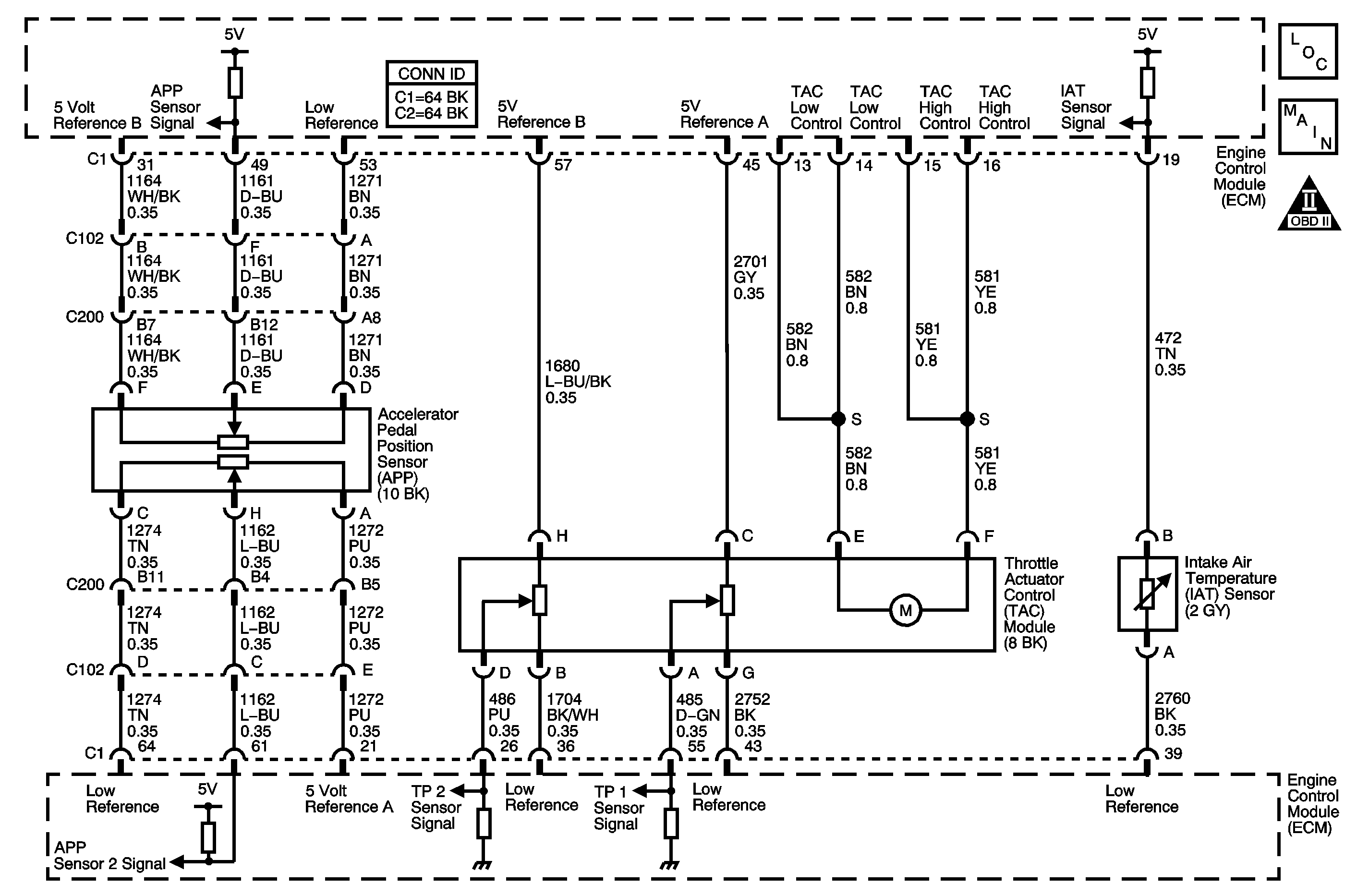
Circuit Description
The engine control module (ECM) uses the following information in order to calculate an expected airflow rate:
| • | The throttle position (TP) |
| • | The barometric pressure (BARO) |
| • | The intake air temperature (IAT) |
| • | The engine RPM |
If the ECM detects the airflow rate is more than expected, DTC P0068 will set.
DTC Descriptor
This diagnostic procedure supports the following DTC:
DTC P0068 Throttle Body Airflow Performance
Conditions for Running the DTC
| • | DTCs P0120, P0122, P0123, P0220, P0222, P0223, P0641, P0651 are not set. |
| • | The engine is running and the engine speed is more than 600 RPM. |
| • | DTC P0068 runs continuously when the above conditions are met. |
Conditions for Setting the DTC
The ECM detects that the calculated airflow rate is more than expected for more than 0.2 second.
Action Taken When the DTC Sets
| • | The control module illuminates the malfunction indicator lamp (MIL) when the diagnostic runs and fails. |
| • | The control module records the operating conditions at the time the diagnostic fails. The control module stores this information in the Freeze Frame and/or the Failure Records. |
| • | The control module commands the TAC system to operate in the Reduced Engine Power mode. |
| • | A message center or an indicator displays Reduced Engine Power. |
| • | Under certain conditions the control module commands the engine OFF. |
Conditions for Clearing the MIL/DTC
| • | The PCM will turn OFF the malfunction indicator lamp (MIL) during the third consecutive trip in which the diagnostic has run and passed. |
| • | The history DTC will clear after 40 consecutive warm-up cycles have occurred without a malfunction. |
| • | The DTC can be cleared by using a scan tool. |
Test Description
The numbers below refer to the step numbers on the diagnostic table.
-
This step will determine if the manifold absolute pressure (MAP) sensor voltage is within the proper range at idle.
-
This step will determine if the MAP sensor responds properly to the change in manifold pressure.
-
A throttle blade that sticks or binds may set this code. Opening the throttle will indicate problems such as these.
-
When the ECM detects a condition within the ETC system, other DTCs may set due to the many redundant tests run continuously on this system. Locating and repairing one individual condition may correct more than one DTC. Keep this in mind when reviewing captured DTC info.
Step | Action | Values | Yes | No | ||||||
|---|---|---|---|---|---|---|---|---|---|---|
Schematic Reference: Engine Controls Schematics Connector End View Reference: Engine Controls Connector End Views or Engine Control Module Connector End Views | ||||||||||
1 | Did you perform the Diagnostic System Check - Vehicle? | -- | Go to Step 2 | Go to Diagnostic System Check - Vehicle in Vehicle DTC Information | ||||||
2 | Are DTCs P0641 or P0651 also set? | -- | Go to Diagnostic Trouble Code (DTC) List - Vehicle in Vehicle DTC Information | Go to Step 3 | ||||||
3 |
Important: If the engine cranks but does not start, go to Step 5. Did the DTC fail this ignition? | -- | Go to Step 4 | Go to Intermittent Conditions | ||||||
4 | Inspect for the following conditions:
Did you find and correct the condition? | -- | Go to Step 8 | Go to Step 5 | ||||||
Observe the MAP sensor voltage parameter with a scan tool. Is the MAP sensor voltage within the specified range? | 0.8-4 V | Go to Step 6 | Go to DTC P0106 | |||||||
Does the MAP sensor kPa change smoothly and gradually as the engine speed is increased and returned to idle? | -- | Go to Step 7 | Go to DTC P0106 | |||||||
Caution: Turn OFF the ignition before inserting fingers into the throttle bore. Unexpected movement of the throttle blade could cause personal injury.
Did you find and correct the condition? | -- | Go to Step 8 | Go to Diagnostic Aids | |||||||
8 |
Did the DTC fail this ignition? | -- | Go to Step 2 | Go to Step 7 | ||||||
Observe the Capture Info with a scan tool. Are there any DTCs that have not been diagnosed? | -- | Go to Diagnostic Trouble Code (DTC) List - Vehicle in Vehicle DTC Information | System OK | |||||||
